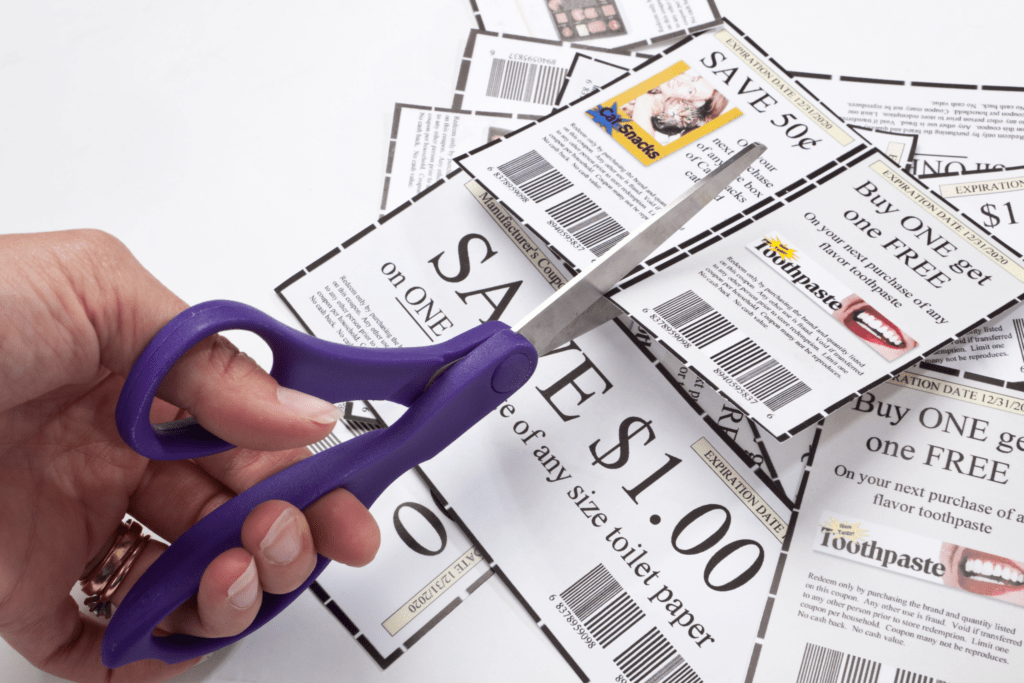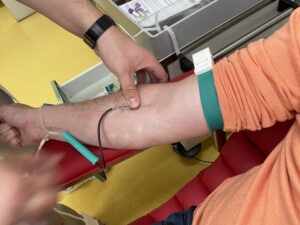You can save big on many items at the grocery store with a little planning and strategies like stacking and stockpiling.

Couponing doesn’t require spending your Sunday cutting newspapers into tiny squares. It can be much easier. But, it can be overwhelming to dive in without having a plan.
Here’s how to save money with coupons — as told by coupon pros. From finding a coupon database to making a shopping list, these beginner coupon tips can save you money at grocery stores and drugstores.
1. ‘Stack’ store and manufacturer’s coupons
There are two major kinds of coupons that you should know about before you start. Store coupons are issued by a specific retailer and can only be used at those locations. Likely, you’ll find these in the newspaper (the Sunday paper usually has the most coupons), in retailers’ online apps, or even in flyers in the mail. Look for “store coupon” in the fine print.
Manufacturer’s coupons, on the other hand, are just that: coupons issued by the manufacturer that can be used at any retailer that accepts them.
The best scenario is using a store coupon and manufacturer’s coupon together to get an even deeper discount. This is called “coupon stacking” and it can save you big at the register.
2. Find a coupon database
Coupons used to be easy to find, but lately, print coupons — like the ones found in your local newspaper — are in short supply. Not to mention, you likely need a newspaper subscription to get your hands on those weekly flyers.
The good news is there are plenty of free places to look. Downloading the apps from your favorite retailers can get you access to digital coupons that you can “clip” on your phone, saving you the chore of having to present a stack of paper coupons at the register.
Another option? Coupon databases are websites that aggregate coupons in one place, so it’s easy to find deals, says Jenny Martin, the writer behind frugal-living website Southern Savers. Search online for the words “coupon database” to find one you like. Some databases allow you to search by coupon type — like a printable, newspaper insert, or mobile coupon — and you can even search your own local newspaper for nearby deals.
3. Read the fine print
There’s nothing more frustrating than getting to the register to find out the great deal you thought you were getting is not valid or redeemable. Read the fine print of the coupon, says Roland Karim of Coupon Pro, a coupon blog.
Check redemption requirements (like what size bottle of orange juice qualifies for the coupon). If you find a good deal and want to redeem multiple coupons, you’ll need a separate one for each item you buy. There may be a limit as to how many of each coupon you can use per transaction.
4. Learn your store’s coupon policy
Coupon policies vary, so look up your local store’s rules. Martin says you can usually find these online or go in person and ask.
Here’s what to pay attention to, according to Martin:
- Can you double a coupon? Some stores will double your coupon, up to a certain threshold. That means if you have a 50-cents-off coupon, the store will take $1 off.
- Do you need to join the loyalty program? You may need to create a loyalty program account with the store and scan your rewards card in order to claim some coupons.
Once you learn your store’s policies and start shopping there regularly, you might realize that you are more in tune with its sales cycles. This will allow you to stock up on things, like your favorite cereal, when they’re on sale because you know they’re likely not going back on sale until next month.
5. Make a shopping list
Maintaining a shopping list will make couponing easier. Know which products you plan to buy at the store so you can find coupons that match the things on your list.
Downloading a shopping list app can keep you organized and can make hunting for coupons easier. An app like AnyList allows you to create shareable grocery lists that you or other family members can edit. It organizes your list based on categories like dairy, pasta, or produce so you can easily navigate the aisles.
You can also make a little money off of making a grocery list. Free coupon apps allow you to log in and digitally clip coupons for products on your list. Some let you scan receipts to get cash back. Sure, it might take some more prep and planning, but the results could be worth it as your savings pile up.
If that seems too tedious, an app like Fetch allows you to upload receipts from pretty much any store and get points for featured products. Once you earn a certain number of points, you can redeem them for gift cards to use at many major retailers.
6. Create a stockpile
When you find a good sale, buy a few of the items — if you know you’ll use all of them before they expire. Items that are particularly good for stockpiling are nonperishable goods (e.g., canned goods, rice, flour, pasta), personal care items (e.g., shampoo, conditioner, soap), and other household items (e.g., toilet paper, laundry detergent, cleaning supplies).
Creating a small stockpile allows you to dictate how much you pay — rather than letting the retailer dictate, according to Cindy Livesey, a frugal-living expert from coupon website Living Rich With Coupons. For instance, if you run out of toilet paper, you’ll pay the current price. But if you have a few extra packages on hand, you can monitor prices and time your purchase accordingly.
This strategy can be especially important in the current economy, where prices for household goods are rising due to inflation. If you can score a good deal on items you know you will use, buying them at their price now could save you money in the coming months.
7. Use coupons strategically
Don’t use coupons solely because you find them. Livesey says sometimes a sale-priced item with no coupon is cheaper than a full-priced item with a coupon.
Pay attention to annual sales, she advises. Pens and pencils go on sale in August around back-to-school season. Baking supplies go on sale in November around the holidays. When possible, look for coupons that correspond with these periods to amplify savings.
If you find the coupon first, Karim recommends holding on to it until you find a sale to combine it with. But pay attention to the expiration date, or you may wait too long to use it.
8. Start with 10 coupons
Start small. Martin recommends browsing your store’s ad and picking 10 items that are on sale. Then, pair coupons with these items. Finally, head to the store.
“It’s kind of setting you up for a small win, which is a great way to get started,” Martin says. “You got your 10 items, you used all of your coupons, you saw that the store didn’t treat you horribly — and they took everything. And you saw how much you saved, and that’s the best part.”
9. Track your savings
Track your results to see if the amount you’re saving is worth the effort. The time and work you invest in couponing is completely up to you. Some coupon experts have created spreadsheets for you to download. Search for “coupon savings spreadsheet” and find an option that works best for you. Then, enter in information like total spending, discounts, rebates, and other information to calculate your total savings.





















